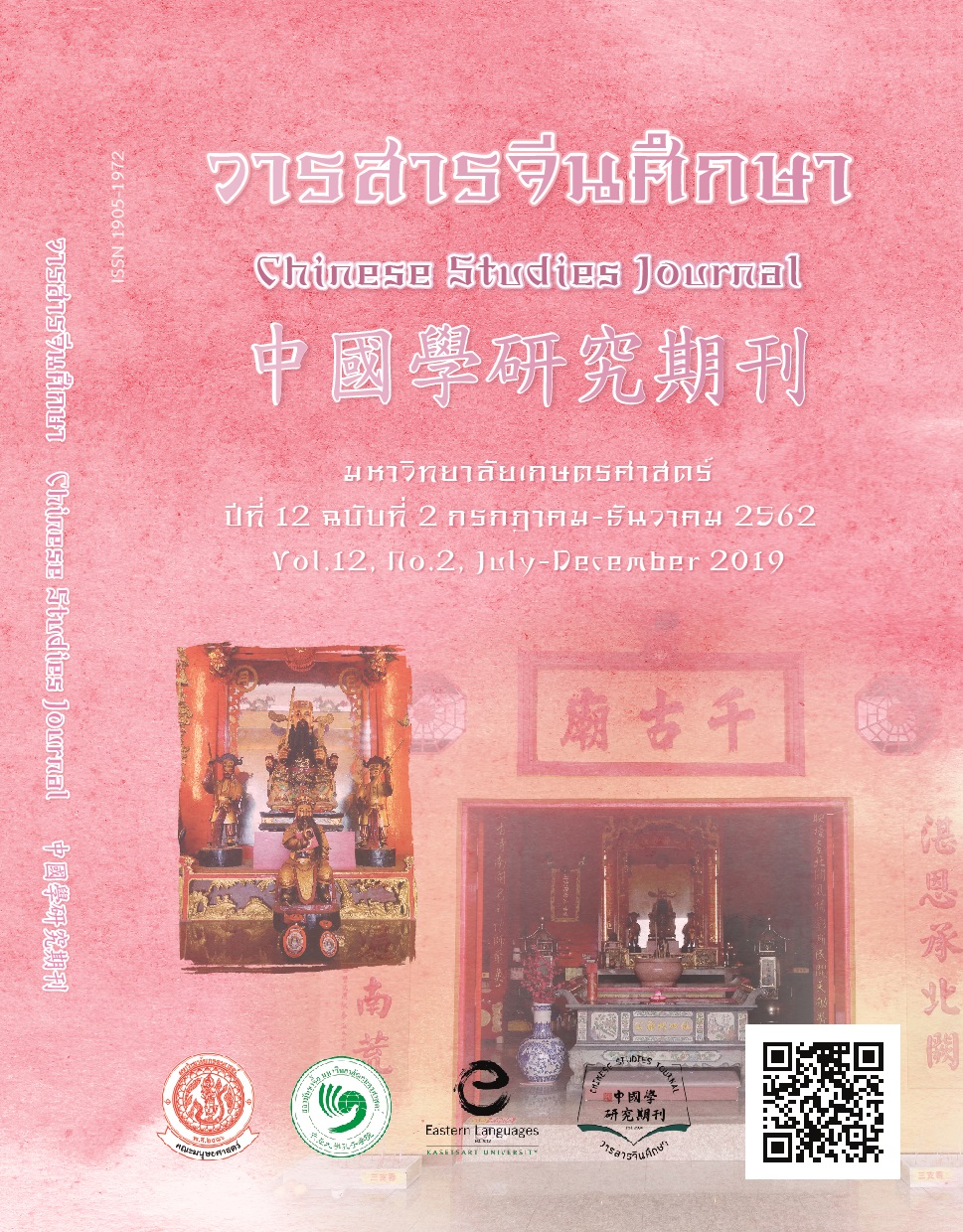Principles and Precautions in Translating Chinese to Thai Language andThai to Chinese Language
Main Article Content
Abstract
The translation is a basic thing that every foreign language learner must encounter, whether to translate foreign languages into mother tongue or to translate mother tongue into foreign languages. Since each language is unique, and has different characteristics, causing translators sometimes encounter difficulties in translation. In this article, the author presents 10 interesting points of the principles and precautions in translating Chinese Language to Thai and Thai Language to Chinese, including
- A word has many meanings and many functions. It is necessary to know clearly what the meaning of the sentence is and what its function is. Then think of the word that is appropriate for both meaning and language level.
- Even the words in Thai and Chinese language have overlapping meanings, but the word meaning width is not equal; therefore, the translator must be careful when choosing the word in translation.
- Words that are proper nouns must be translated in accord with the existing practices and tradition. If need to create the new words, In case of translation from Chinese into Thai language, the right font must be chosen. And, when translating from Thai into Chinese language, word choosing and transcribing are particularly concerned.
- Words that are animal or plant names, those always have to be searched for scientific names for translation.
- The order and the familiarity of date, month, year, and address must be adjusted to match with nature and characteristics of the destination language.
- Numbers and classifiers must be adjusted to match the familiarity and characteristics of the destination language.
- Translation of idioms, proverbs, and aphorisms into plain language, or into destination language’s idioms must be careful with the differences in meaning and tone of the speeches.
- Learn how to cut, add, and adjust the text to suit the way of expression in the destination language.
- Arrange sentences according to the structure of the destination language or according to popularity in the destination language.
- In case that the order of the original text is difficult to understand, the translator is able to arrange the sequence as
Due to the variety of translation content; therefore, it is important to study the principles and precautions of translation, because it will make the translator able to apply the principles to improve their translation skills. In addition, the principles must be considered, adjusted, brought in use by appropriate situations.
Article Details
ผลงานทางวิชาการที่ลงตีพิมพ์ในวารสารจีนศึกษา มหาวิทยาลัยเกษตรศาสตร์ เป็นลิขสิทธิ์ของผู้เขียนหรือผู้แปลผลงานนั้น หากนำลงในวารสารจีนศึกษาเป็นครั้งแรก เจ้าของผลงานสามารถนำไปตีพิมพ์ซ้ำในวารสารหรือหนังสืออื่นได้โดยมิต้องแจ้งให้ทราบล่วงหน้า แต่หากผลงานที่ได้รับพิจารณานำลงในวารสารจีนศึกษา เป็นผลงานที่เคยตีพิมพ์ที่อื่นมาก่อนเจ้าของผลงานต้องจัดการเรื่องปัญหาลิขสิทธิ์กับแหล่งพิมพ์แรกเอง หากเกิดปัญหาทางกฎหมาย ถือว่าไม่อยู่ในความรับผิดชอบของวารสารจีนศึกษา มหาวิทยาลัยเกษตรศาสตร์ ทั้งนี้ ความคิดเห็นต่างๆ ในบทความเป็นความคิดเห็นส่วนตัวของผู้เขียน ไม่เกี่ยวกับกองบรรณาธิการวารสารจีนศึกษา มหาวิทยาลัยเกษตรศาสตร์
References
นววรรณ พันธุเมธา. 2551. ไวยากรณ์ไทย. พิมพ์ครั้งที่ 5. กรุงเทพมหานคร: โครงการเผยแพร่ผลงานทางวิชาการ คณะอักษรศาสตร์ จุฬาลงกรณ์มหาวิทยาลัย.
ธานินทร์ กรัยวิเชียร.2562. ภาษากฎหมายไทย. พิมพ์ครั้งที่ 12. กรุงเทพมหานคร: สำนักพิมพ์มหาวิทยาลัยธรรมศาสตร์.
ประพิณ มโนมัยวิบูลย์. 2541. ไวยากรณ์จีนกลาง. กรุงเทพมหานคร: โครงการตำราคณะอักษรศาสตร์ จุฬาลงกรณ์มหาวิทยาลัย.
ปรียา อุนรัตน์. 2539. การแปลอังกฤษเป็นไทย: แนวคิดและวิธีการ. กรุงเทพมหานคร: สำนักพิมพ์ดวงกมล.
รัชนีโรจน์ กุลธำรง. 2552. ความรู้ความเข้าใจเรื่องภาษาเพื่อการแปล จากทฤษฎีสู่การปฏิบัติ. กรุงเทพมหานคร: สำนักพิมพ์แห่งจุฬาลงกรณ์มหาวิทยาลัย.
ราชบัณฑิตยสถาน. 2556. พจนานุกรม ฉบับราชบัณฑิตยสถาน พ.ศ. 2554. พิมพ์ครั้งที่ 2. กรุงเทพมหานคร: นานมีบุ๊คส์พับลิเคชั่น.
วัลยา วิวัฒน์ศร. 2545. การแปลวรรณกรรม. กรุงเทพมหานคร: โครงการเผยแพร่ผลงานทางวิชาการ คณะอักษรศาสตร์ จุฬาลงกรณ์มหาวิทยาลัย.
ส.ศิวรักษ์. 2545. ศิลปะแห่งการแปล. พิมพ์ครั้งที่ 6. กรุงเทพมหานคร: สำนักพิมพ์มูลนิธิเด็ก.
สัญฉวี สายบัว. 2545. หลักการแปล: กิจกรรมสู่ความเข้าใจ. พิมพ์ครั้งที่ 2. กรุงเทพมหานคร: สำนักพิมพ์มหาวิทยาลัยธรรมศาสตร์.
สัญฉวี สายบัว. 2550. หลักการแปล. พิมพ์ครั้งที่ 8. กรุงเทพมหานคร: สำนักพิมพ์มหาวิทยาลัยธรรมศาสตร์.
อุษา โลหจำรูญ. 2547. ชีวิตและงานของพระถังซัมจั๋ง. กรุงเทพมหานคร: มหาวิทยาลัยมหาจุฬาลงกรณราชวิทยาลัย.
ภาษาจีน
陈福康. 2000.《中国译学理论史稿(修订本)》. 上海:上海外语教育出版社.
高华丽. 2008.《翻译教学研究:理论与实践》. 杭州:浙江大学出版社.
赫胥黎原著、严复译述. 1933.《天演论》. 上海:商务印书馆.
胡适、姜义华、沈寂. 1993.《胡适学术文集》. 北京:中华书局.
黄忠廉. 2002.《变译理论》. 北京:中国对外翻译出版公司.
慧皎等. 1991.《高僧传合集》. 上海:上海古籍出版社.
梁源灵. 2009.《泰汉翻译理论与实践》. 重庆:重庆大学出版社.
刘宓庆. 2004.《口笔译理论研究》. 北京:中国对外翻译出版公司.
鲁迅先生纪念委员会. 1973.《鲁迅全集》. 北京:人民文学出版社.
罗新璋. 1984.《翻译论集》. 北京:商务印书馆.
欧阳哲生. 1998.《胡适文集》(2). 北京:北京大学出版社.
释僧祐.1995.《出三藏记集》. 北京:中华书局.
谭国安、梁忠翥、萧榕. 2009. 《实用泰汉翻译教程》. 北京:北京语言大学出版社.
王述文. 2008.《综合汉语翻译教程》. 北京:国防工业出版社.
许钧. 2003.《论翻译》. 武汉:湖北教育出版社.
张培基. 1983.《英汉翻译教程》. 上海:上海外语教育出版社.
郑和平. 2006.《英译汉使用教程》. 广州:中山大学出版社.
中国社会科学院语言研究所词典编辑室.2016(2017.5重印).《现代汉语词典》(第七版). 北京:商务印书馆
仲伟合、王斌华. 2009.《基础口译》. 北京:外语教学与研究出版社.
朱志瑜、朱晓农. 2006.《中国佛籍译论选辑评注》. 北京:清华大学出版社.
ภาษาอังกฤษ
Newmark, Peter. 1988. A Textbook of Translation. London: Prentice Hall International (UK) Ltd.
Nida, Eugene A., and Charles R.Taber. 1982. The Theory and Practice of Translation. Second photomechanical reprint. Leiden E.J. Brill: The United Bible Society.
รายการอ้างอิงตัวอย่างการแปล
คำกล่าวต้อนรับศาสตราจารย์ ดร.ชิวจิ้นและคณะจากมหาวิทยาลัยหัวเฉียว. 2553.(อัดสำเนา).
คำกล่าวในพิธีเปิดป้ายสถาบันขงจื๊อ มหาวิทยาลัยเกษตรศาสตร์. 2551.(อัดสำเนา).
คำกล่าวรายงานเปิดการประชุมผู้บริหารระดับสูงมหาวิทยาลัยเกษตรศาสตร์ ครั้งที่ 1. 2545.(อัดสำเนา).
เครือข่ายพุทธิกาเพื่อพระพุทธศาสนาและสังคม. 2553. อังคาร กัลยาณพงศ์ “ความสุขคือการเรียนรู้” . [ออนไลน์].เข้าถึงได้จาก:http://www.budnet.org/happiness/goodandfamous/
22.html. [วันที่เข้าถึง 11 ธันวาคม 2553]
มหาวิทยาลัยเกษตรศาสตร์. 2552ก. ข้อมูลทั่วไป. [ออนไลน์].เข้าถึงได้จาก: http://www.ku.ac.th/
about/general.html. [วันที่เข้าถึง 10 พฤศจิกายน 2552]
มหาวิทยาลัยเกษตรศาสตร์. 2552ข. หน่วยงาน. [ออนไลน์].เข้าถึงได้จาก: http://www.ku.ac.th/
department/. [วันที่เข้าถึง 10 พฤศจิกายน 2552] สเปรย์โลชั่นหอมกันยุง. ม.ป.ป. [แผ่นพับ].
中国传统节日. [ออนไลน์].เข้าถึงได้จาก: https://baike.baidu.com/item/%E4%B8%AD%E5%9B%BD%E4%BC%A0%E7%BB%9F%E8%8A%82%E6%97%A5/396100?fr=aladdin [วันที่เข้าถึง 30 กันยายน 2562]


